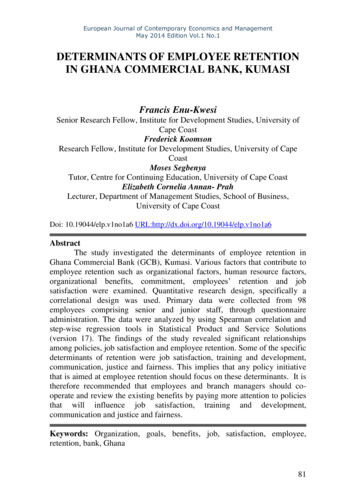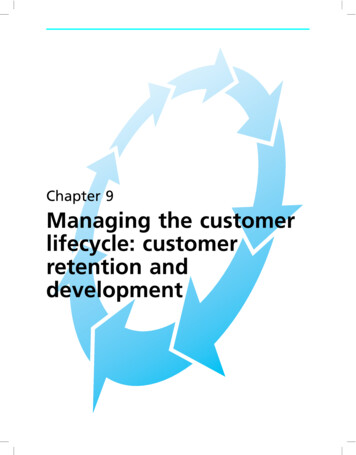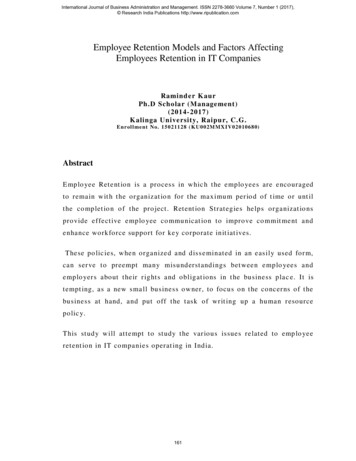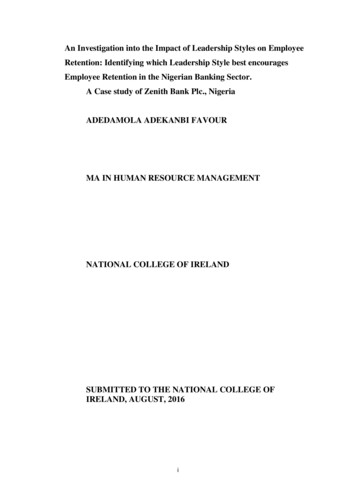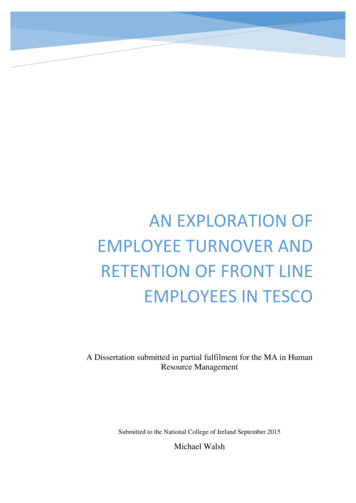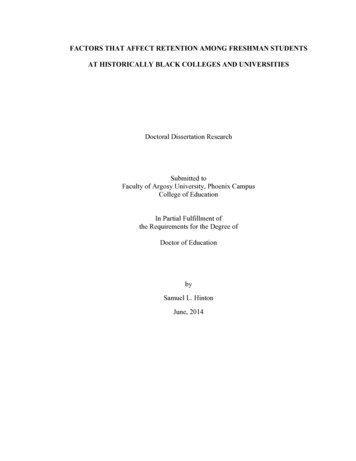
Transcription
FACTORS THAT AFFECT RETENTION AMONG FRESHMAN STUDENTSAT HISTORICALLY BLACK COLLEGES AND UNIVERSITIESDoctoral Dissertation ResearchSubmitted toFaculty of Argosy University, Phoenix CampusCollege of EducationIn Partial Fulfillment ofthe Requirements for the Degree ofDoctor of EducationbySamuel L. HintonJune, 2014
iiFACTORS THAT AFFECT RETENTION AMONG FRESHMAN STUDENTSAT HISTORICALLY BLACK COLLEGES AND UNIVERSITIESCopyright 2014Samuel L. HintonAll rights reserved
iiiFACTORS THAT AFFECT RETENTION AMONG FRESHMAN STUDENTSAT HISTORICALLY BLACK COLLEGES AND UNIVERSITIESDoctoral Dissertation ResearchSubmitted to theFaculty of Argosy University, Phoenix Campusin Partial Fulfillment ofthe Requirements for the Degree ofDoctor of EducationBySamuel L. HintonArgosy UniversityJune, 2014Dissertation Committee Approval:Dr. SusanAdragnaDigitally signed by Dr. Susan AdragnaDN: cn Dr. Susan Adragna, o ArgosyUniversity, ou,email sadragna@argosy.edu, c USDate: 2014.07.08 17:03:07 -04'00'Susan Adragna, Ph.D., ChairAndrea Thompson,PhDDigitally signed by Andrea Thompson, PhDDN: cn Andrea Thompson, PhD, o, ou,email mthomp1001@aol.com, c USDate: 2014.07.09 19:19:23 -04'00'Andrea Thompson, Ph.D., MemberDateJames M.MitchellProgram ChairDigitally signed by James M. MitchellDN: cn James M. Mitchell, o, ou,email MitchellCSUEB@aol.com,c USDate: 2014.07.09 19:25:37 -07'00'
ivFACTORS THAT AFFECT RETENTION AMONG FRESHMAN STUDENTSAT HISTORICALLY BLACK COLLEGES AND UNIVERSITIESAbstract of Doctoral Dissertation ResearchSubmitted to theFaculty of Argosy University, Phoenix CampusCollege of EducationIn Partial Fulfillment ofthe Requirements for the Degree ofDoctor of EducationbySamuel L. HintonArgosy UniversityJune 2014Susan Adragna, Ph.D.Andrea Thompson, Ph.D.Department: College of Education
vAbstractThe retention of rates for freshmen students in Historically Black Colleges andUniversities had been comparably low leading to low graduation rate. In order tounderstand this phenomenon, there was a need to investigate the factors that affectedretention rates of freshmen students in HBCU Institutions. The retention of students inhigher education was an ongoing problem. It was estimated that half of all studentsentering higher education would drop out before earning a degree. The purpose of theresearch was to make recommendations on how HBCU Institutions could effectivelyimplement programs and strategies to retain freshmen students in the Institution untiltheir graduation. A qualitative phenomenological design was used to collect the livedexperiences of 15 respondents selected from one HBCU Institution. The data collectedwas analyzed and findings presented in a narrative form. The results indicated thatmajority freshmen students in HBCUs are susceptible to many factors includingenvironmental and social that can affect their retention in school. The results alsorevealed that HBCU Institutions are putting in place systems and programs to ensureretention of freshmen students remains high. The study recommends that futureresearchers should investigate the role that family and family ties play in the retentionrates of freshmen in HBCUs.
viACKNOWLEDGEMENTSI would like to first thank God for this awesome journey. Without him I would benothing. My life would be like a ship without a sail. I can truly say this is the Lords doingand it is marvelous in our eyes! I acknowledge my Father and Mother, Mr. SamuelThomas Hinton and Mrs. Robbie M. Springs-Hinton. I owe my life to these twoindividual. They sacrificed so that I may become. I am forever grateful. You bothallowed me to pursue a college education when you both did not get a chance to pursueone. Love you both! A special thanks to Dr. Susan Adragna, thank you for yourunconditional guidance throughout my dissertation process. You are the best chair anydoctoral candidate can have. Dr. Andrea Thompson, my committee member for yourexpertise in my topic and background. You made revisions easy and understandable. ToDr. Dan Ruff, thank you for your guidance as my professor and mentor in graduateschool and post graduate school thank you for believing in me.Secondly, I would like to thank my ride or die friends who have been with methroughout this journey. I am sure they are excited that this milestone is over lol. Mr andMrs. Kevin and Kristy Quattlebaum, words cannot adequately express my love andfriendship you have shown. You have been there throughout the writing, revisions,PowerPoints and frustrations! Mrs. Marsha Gunter-Brown, I don’t have enough pages toexpress what I really want to express. You have prayed and encouraged me through thegood, bad and the ugly! I love you unconditionally! Mr. and Mrs. John and Joanna Ayers,whew!!!! Through it all!!! To my spiritual leaders Pastor James and Lady AndrenaRowson, words cannot adequate express my love for the both of you. Pastor James nowyou can stop asking, “when is it over” lol. I can tell you both “It was good that I was
viiafflicted” My faith level will never be the same. I think God strategically ordered thisprocess to be without only to “Trust Him” and remaining “Faithful” to the call of service.Lastly, I would like to personally thank Dr. Ronnie Hopkins. Since fall 2001, youhave been a mentor not only fraternal but educational. You have shown what it means tobe a real fraternal brother as well as a friend. You made my process easy even when Iwas worried about collecting data you were brainstorming on an effective way to get itfinish. I am grateful for your guidance! Much Love! Last favor, I need a job lol! To VyceJohnson my technical and software person you helped me get ready for IRB approval lol.To Colin Myers, man you already know! Because of your obedience God will reward youfar beyond your imagination! To Dr. Anthony Driggers, thank you for yourencouragement and mentorship! To Dr. Barbara Woods, Dr. William Hine, Dr. JackieBooker, Dr. Cornelius Sinclair, Dr. Anthony Thompson and Dr. John Simpson thank youfor believing in me! To Bishop (Mayor) Michael Butler, the prophecy you gave to meyears ago has come to fruition!I must acknowledge as well the many friends, colleagues, students and professors,who assisted, advised, and supported my research.
viiiDEDICATIONThis dissertation is dedicated in the memory of my father the late Mr. SamuelThomas Hinton. I will always be appreciative for all that you done to make sure I had thebest in everything. Thank you for being “Mr. Mom” lol when Mom had to work late andyou step up to the plate to be at all my high school track meets (running on the sideshouting “run son”) and my concert choir concerts. Thank you for being a proud fatherwho loved to see his son teach and direct choirs especially South Carolina StateUniversity Gospel Choir. Thank you for being my number #1 fan in everything Iaccomplished. Your death was untimely in the natural and I miss and love you daily Dad!
ixTABLE OF CONTENTSPageCHAPTER ONE: INTRODUCTION .1Problem Background .3Significance of the Problem .4Purpose of the Study .6Research Questions .6Limitations and Delimitations.7Limitations .7Delimitations .7Definitions of Terms .8Theoretical Framework .9Initial Review of the Literature .10Different Perspectives about HBCUs .10Existing Retention Strategies, Their Shortcomings and Their Benefits .11Researched Factors that Affect Retention at HBCUs .12Strategies to Address the Challenges to Retention of First Year Students inHBCUs .13Conclusion and Recommendation .14CHAPTER TWO: REVIEW OF THE LITERATURE .15Different Perspectives on HBCUs .16Theoretical Explanation: Factors that Influence the Retention of the FreshmanStudents at HBCUs during the First-year Experience .19Individual Factors that Affect Retention among Black Students.23Student’s Level of Involvement .23The Background Characteristics of Students .24Place of Residence .26First Year College Grades .26Financial Barriers .27Existing Retention Strategies, Their Shortcomings and Benefits .30Social Integration/Social Involvement .31First Year Programs .33Meyerhoff Scholars Program .35Freshman Year Inititative .36Counseling and Coaching .36Model Institutions for the Excellence Program .39The State of Retention among the Freshman Students at HBCUs during theFirst-year Experience .40Strategies to Address the Challenges to Retention of the First Year Studentsin HBCUs .42Conclusion .45
xCHAPTER THREE: METHODOLOGY .47Introduction .47Research Design.47Population and Selection of Participants .49Data Collection .50Methodological Assumptions .51Procedures .51Data Processing and Analysis .52Research Bias .54Ethical Considerations .54Chapter Summary .56CHAPTER FOUR: RESEARCH FINDINGS .56Restatement of the Purpose.56First Year Experience for Freshman Students at HBCUs .56Factors that Influence Freshman Students to Persist during the First-year Experience .60Practices used to Retain Freshmen Students at HBCUs during the First-yearExperience.61The Proposed Retention Strategies at HBCUs.63Meaningfulness and Essence of the Lived Experiences of Freshmen Studentsat HBCUs .65CHAPTER FIVE: SUMMARY, CONCLUSIONS, ANDRECOMMENDATIONS .69Summary .69Conclusion .73Recommendations .74REFERENCES .78APPENDICES .87A. Structured Open-Ended Questions for Interview .88B. Consent Form .90C. Survey. 92
1CHAPTER ONE: INTRODUCTIONDespite the large number of freshmen who were admitted each year atHistorically Black Colleges and Universities (HBCU), a low number of students couldgraduate (Tinto, 1993). Research indicated that HBCUs could do more to retainfreshmen students (Tinto, 1993). Retention research in higher education suggested thatincreased student involvement with campus life led to greater integration into the socialand academic systems of the institution and promoted retention (Tinto, 1993).Educational theorists such as Alexander Astin and Vincent Tinto had long pointed to theimportance of social integration, or what was more commonly referred to as socialinvolvement, in retaining college students. Astin (1984) contended that studentinvolvement was a condition for student retention. Based on his theory, Astin (1984)believed that the more students were socially involved with campus life, the more likelythey would persist and graduate. Developing and implementing a comprehensive studentfirst-year program required a commitment from leaders, faculty, and staff. According toSwail et al. (2003), a comprehensive student retention program should: (a) rely on provenfacts, (b) involve all campus departments and personnel, (c) focus on students, (d) ensurethe program is fiscally responsible, (e) monitoring of students and programs and (f) besensitive to students’ needs and student population.Tinto (1993) stated that student retention could be defined as the ability of aninstitution of higher education to keep students enrolled and then graduate those students.It is a complex process shaped by various forces, factors and relationships. Since the1970s, colleges and universities had increasingly recognized declining rates of studentretention as a critical issue (Strommer, 1993). Tinto indicated that 41 out of every 100
2freshman departed higher education without obtaining a college degree (Tinto, 1993).Most freshman students left within 2 semesters of study (Tinto, 1993).Hundreds, if not thousands, of specific reasons a student might leave collegebefore graduation existed, they included: financial variables, academic success, andpersonal factors. Recent decades had seen a steady increase in college enrollment rates,which had not been accompanied by a corresponding increase in graduation rates (Tinto,1993). Student retention, especially in the first and second years of study, had become achallenging problem for higher education community and a major concern for allpostsecondary institutions (Tinton, 1993). Student persistence was one of the moststudied phenomena in higher education and continued to be a primary concern forcolleges and universities.Retention of Black students was one of the most challenging problems in highereducation. The national average retention rate of Black students was reported at 45%(Rowser, 2001). Institutions of higher education state funding was tied to theirgraduation and retention rates. Retention theories and studies lacked the understandingof the various factors that could contribute to the retention specifically Black freshmenstudents attending HBCUs. As a result, limited research on factors that influence Blackstudent overall persistence existed.A holistic approach was very much needed to address factors that affectedretention among freshman students at HBCUs. The issues, however, were common tomany institutions but could be addressed with the appropriate resources, resolve, anddedicated faculty and staff (Rowser, 2001). Having an assessment component to all of
3the initiatives that could be implemented to address the challenges that Black studentsface is critical to the retention of students attending HBCUs.Problem BackgroundThe retention of minority students had been widely acknowledged as one of themost challenging problems of higher education (Craig, 2011). At the time of the study,the national average retention rate of freshman minority students is 45% within five yearsof study as compared to 57% for the White majority students (Craig, 2011). In addition,statistics indicated that higher academic institutions lost about 20% of their student’s inthe first year, 11% in the second year and 9% in the third year (American College TestingProgram (ACT), 2010). Townsend (2007) stated half of all students that were enteringinstitutions of higher education dropout before earning their degree. In addition,approximately 57% of all college dropouts left college before the beginning of the secondyear (Townsend, 2007).Society placed great value on obtaining a college or university education. Blackcollege student completion rates had traditionally been lagging behind those of theirWhite and Asian counterparts (Townsend, 2007). This significant departure from highereducation did not only affect the society in general, but also the Black students inparticular. According to Townsend (2007), low Black student retention rates were amajor concern because their withdrawals from college before earning their degree couldadversely affect their quality of life. A college education was important to overcomingbarriers related to poverty and adverse social situations and in minimizing the economicand educational disparity that exists between Black and White students.
4In an effort to ensure retention and minimized educational and economicdisparities that existed between the African Americans and the Whites, Historically BlackColleges and Universities (HBCUs) were created. Gasman and Tudico (2010) notedthese institutions were established prior to 1965 when racial segregation in America wasthe order of the day. By the time of the study, HBCUs had continued to provide highereducational opportunities for Blacks who had otherwise not attended college. Wright(2008) indicated that, HBCUs enrolled over 26% of all Black students and produce 28%of the bachelor degree holders who were Black. Despite these significant endeavors, theHBCUs still struggled with low retention rates. The ACT (2010) observed that HBCUsand other open admissions institutions had the lowest freshman-to-sophomore retentionrates among all public 4-year higher education institutions.ACT (2010) reported that, despite the fact that HBCUs invested a lot in a varietyof programs dedicated to improving Black students’ persistence, retention rates had notbeen improving over time. Determining ways of improving Black students’ retentionrates (especially in the first year) would benefit the Black students, the HBCUs, as wellas society. This was the reason HBCUs granted a high percentage of bachelor degrees tothe African American population. The current paper was a proposal on identifying thefactors that affected retention among freshmen students at Historically Black Collegesand Universities (HBCU) during the first-year experience.Significance of the ProblemRetention among freshmen students at HBCUs during the first-year experiencewas a major challenge for the Black students. Wright (2008) indicated that a number ofretention projects had been established at most HBCUs by making retention a major part
5of the institution’s mission. Many of the HBCUs, through the support of federal and stateagencies, had established institutional strategies; such as academic support services,counseling and retention centers, remediation, career services, merit based scholarshipsand emergency loans, corroborate and private donations, and Title IV programs likeSummer Bridge and Trio programs (Wright, 2008). Each of these programs played animportant role in improving retention through developing academic skills, social skills,remediation, and providing financial assistance. Love (2010) suggested that the initialyears of the establishment of these programs saw reported benefits such as improvedgrades, enhanced sense of self-worth, and the ability to persevere in school. Despitethese improvements, the issue of retention was not addressed as it continued to persist;where students were dropping out of the HBCUs and joining other mixed race publicuniversities or predominantly White institutions (PWIs) (Love, 2010). The problem withthese strategies was that they failed to address the specific needs facing the first-yearBlack student.Allen (2010) thought academic support and retention services ought to bedesigned in such a way that they address the socio-economic problems faced by first-yearstudents as they maneuvered the obstacles they encountered in campuses. Manyretention programs have not increased the retention rates significantly, as they did notdemonstrate their effectiveness in addressing the factors that increased the retention ofAfrican American students in HBCUs. If these factors were not identified, there is noway in which they could be addressed. This research study was to identify factors thataffected retention among freshmen students during their first-year experience at HBCUs.
6Purpose of the StudyThe purpose of this phenomenological study was to explore factors that influencethe retention of freshmen students at HBCUs during the first-year experience. In additionto the major purpose, this research study had the following specific purposes:1. Identify the state of retention among freshmen students at HBCUs during thefirst-year experience;2. Identify strategies in place at HBCUs to improve retention of freshmen duringtheir first-year experience;3. Identify the problems in the then existing retention strategies;4. Explore what freshmen wanted in order to improve their educationalexperience at HBCUs during the first-year.Research QuestionsThe research study was phenomenological qualitative method. The followingquestions guided this process:1. How do HBCU Freshman describe their first-year experience?2. What factors do HBCU Freshmen students describe as influencing their decisionto persist during the first-year experience?3. What practices do students describe as being in use to retain freshmen students atHBCUs during the first-year experience?4. What retention strategies do freshmen students at HBCUs propose?5. What are the meaningfulness and essences of the lived experiences of freshmenstudents at HBCUs?
7Limitations and DelimitationsAs with any study, there are several things that could cause issues to arise. Thelimitations and delimitations were identified here to discuss some of those issues. Thelimitation of this study was the focus on the number of participants. Results from thisstudy were not transferrable to all HBCUs who had identified factors that affectedretention among freshman students at HBCUs. The delimitation of this study was that itconsisted of students who had entered their first year experience in college as a freshman.Many of these students were first year generation students from low-income groups.LimitationsThis study used a phenomenological qualitative approach where data frominterviews at HBCUs was analyzed. The notion of retention was grounded in studentsuccess. Thus, retention related activities focus on providing a campus environmentwhere students successfully completed their goal and completed their academic programfrom an Institution. This study focused on a limited number of participants of 15freshman students. The research of the findings of the study, and therefore its reliabilitycould be questioned.DelimitationsThis study focused only on the first-year (freshman) students. According toTinton, 41 out of every 100 freshman departed higher education without obtaining acollege degree (Tinto, 1993). Most freshman students left within two (2) semesters ofstudy (Tinton, 1993).This study reviewed literature that dealt with retention strategies in HBCUs only.Tinto (1996) reported that approximately 57% of college dropouts left college before the
8start of the second year. Because society placed great value on obtaining a collegeeducation and Black college student completion rates had traditionally lagged behindthose of Whites and Asians (Swail et al., 2003); such a significant departure from highereducation not only affected our society in general, but also Blacks in particular. LowBlack student retention rates were also a major concern because withdrawing fromcollege before earning a degree could adversely affected an individual’s quality of life(Swail, et al., 2003). The results of this study could not be transferable to all Blackstudents at HBCUs, being that all HBCUs public and private Institutions outcome toretention resulted differently.Definitions of TermsDropout rate: The proportion of pupils/students who leave school during theyear as well as those who complete the grade/year level but fail to enroll in the nextgrade/year level the following school year to the total number of pupils/students enrolledduring the previous school year (ACT, 2010).Freshman student: Students in their first year of study less than 30 credit hours(Wright, 2008).HBCU: Historically Black Colleges and Universities founded for the primarypurpose of educating Black people (Gasman & Tudico, 2010).Minority student: Students from minority groups such as African Americans(Mikyong & Conrad, (2006).PWI: Predominately White Institutions refer to those higher educationinstitutions that have a historical legacy of excluding Blacks and a historically andpredominately white racial composition (Astin, 1984).
9Retention: The outcome of students who remained in enrolled from fall to fall.These students clearly defined educational goals whether they are course credits, careeradvancement, or achievement of new skills (Tinto, 1993).Theoretical FrameworkThe research study was guided by such theories as social interactionist, studentinvolvement framework, and student attrition framework that were to form the frame ofreferences or foundation for the study. The social interactionist framework usedstudents’ backgrounds characteristics; shared values and a friendship to explain behaviorwhile the student attrition framework used intentions attitudes and believe. In integratingthe two theories, the researcher was able to predict or explain the study outcomes and linkthem to the existing body of knowledge. This research presented the theoreticalframework of the study on factors that affected retention among freshman students atHistorically Black Colleges and Universities. The research problem in this paper wasfactors that affected retention among freshman students at HBCUs. This researchproblem anchored the entire study and formed the basis of constructing the study’stheoretical framework. The key variables in this study were the freshman students,retention rates, and the factors affecting retention. This study relied on four sets ofliterature: (a) different perspective about HBCUs, (b) Existing retention strategies, theirshortcomings and benefits, (c) Researched factors that affected retention at HBCUs, and(d) proposals to address the challenges to retention of first year students in HBCUs.This research study made use of a phenomenological design. Thus, it relied onphenomenological theory. Therefore, this phenomenological theory stresses on
freshman departed higher education without obtaining a college degree (Tinto, 1993). Most freshman students left within 2 semesters of study (Tinto, 1993). Hundreds, if not thousands, of specific reasons a student might leave college before graduation existed, they included: fin
